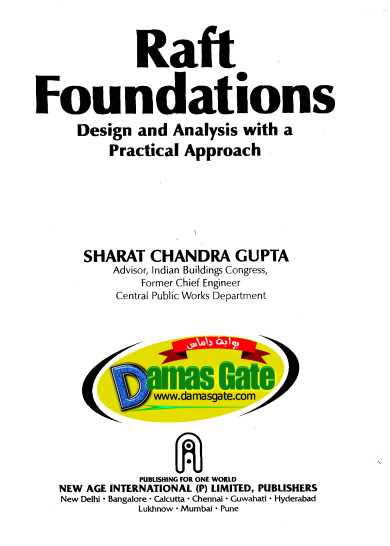Raft Foundation Design And Analysis With A Practical Approach

INTRODUCTION
In 1957, when the author was a student of Civil Engineering at the Indian Institute of Technology, Kharagpur, the first institute of national importance, one of his professors of Civil Engineering at his first lecture in the class said:
"Civil Engineering is 50% common sense but common sense is that sense which is quite uncommon. "
After 34 years of experience in Civil Engineering construction and design, the author only wonders how true the statement of his Professor was and how much more it is true in case of foundation engineering.
1.1 Foundation engineering has been practised as an art, without help of science, since time immemorial upto 1920 when it had achieved a considerable amount of refinement. It was in the earlier 1920s that a concerted
! effort was made to study and undentand the physical laks governing the behaviour of sub surface materials,
\ i.e.. soil from which foundations derived their support and on whose behaviour its own behaviour depends. This is the time when study of soil mechanics was started and it was in 1919 when Karl Terzaghi, popularly known as 'father of soil mechanics', made successful attempt to explain the phenomenon of settlement oti a scientific basis. Though study of soil mechanics has provided us with new techniques for selecting appropriate type of foundation and predicting the behaviour of completed structures, it has not been able to decrease the importance of the accumulated experience of the ages. Amount of uncertainty and degree of variation in the properties of soil and number of parameters on which performance of a foundation depends, make exact solution impractical, if not impossible. With so much of advancement in science and computer application, structural design is still defined as:I5
a creation of a structural fonn to satisfy a number of requirements. It is a combination of art and science. As a rule, there is no direct procedure leading to the solution of a specific problem. An engineer uses all his resources of knowledge experience and imagination to produce a trial scheme. He then constructs a mathematical model of such a solution to assess its adequacy and ifnecessary, modifies the original concept
in the light of analytical results. The process is repeated until the designer is satisfied with thefinalproduct, taking into account not only structural adequacy but also such non-quantifiable factors as aesthetics, ease of construction and performance. The design process is characterised by a complex interaction of
parameters and the need to arrive at decisions based on incomplete data Intuitive decisions which have to be taken, appear to be diametrically opposite to the logical nature of ... '
Download
*
